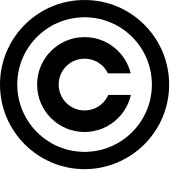 Copyright
Copyright
- Copyright in unpublished works (this covers most material in archives) lasts for at least the life of the author plus 70 years; a term which is longer than it used to be.
- There is a special exemption for libraries and archives to make digital copies of materials for the sole purpose of preservation.
- Works published in the U.S. before 1923 are in the public domain.
- A “fair use” is a use for which you do not have to ask permission. You cannot know in advance whether a use is fair; a judge must determine whether the use was fair after the fact. There are four factors for judging whether a use is fair. All four must be considered; if a use meets one criterion but not another, the use is likely to be judged unfair:
- the purpose and character of the use, including whether such use is of a commercial nature or is for nonprofit educational purposes;
- the nature of the copyrighted work;
- the amount and substantality of the portion used in relation to the copyrighted work as a whole; and
- the effect of the use upon the potential market for or value of the copyrighted work.
- Government records are in the public domain.
There are several tools to help you discover whether a work is copyrighted and whether a planned use is fair, including:
- The Digital Copyright Slider at [http://www.librarycopyright.net/resources/digitalslider/]
- The Fair Use Evaluator at [http://www.librarycopyright.net/resources/fairuse/]
Look for materials that employ the Creative Commons rights management. This system employs symbols that make it easy to know what rights an author claims in their work.
- Search Creative Commons for materials you can use/remix here.
- Wikimedia Commons
- Flickr Commons
Resources for Using Video Clips